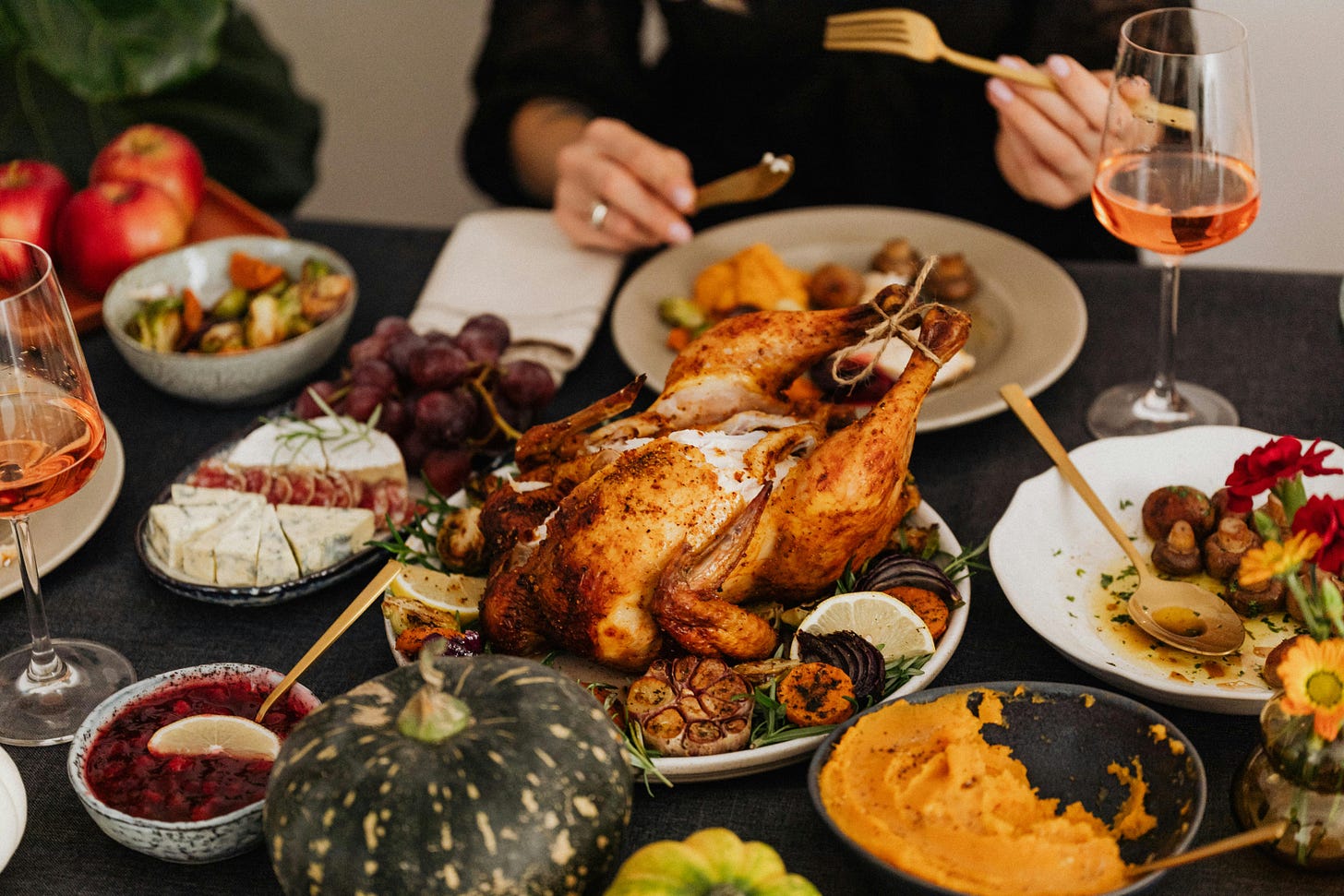Appreciating the Bounty
The historical view of Thanksgiving is about more than the specifics of its origins, it's about why successive generations of Americans kept up a tradition of appreciating that which has been given.
Christmas is celebrated in many places throughout the globe. Most countries have an Independence Day of some sort, and many have celebrations to remember those who gave their lives in service (in the United Kingdom, it is called Remembrance Day). And though many nations still have harvest festivals, Thanksgiving is unique to Canada, the United States, and a few other places.
Almost every American has some sense of Thanksgiving as a holiday modeled on a 1621 harvest feast shared by the English colonists (Pilgrims) of Plymouth and the Wampanoag people. But because this holiday could be shaped, like much of America itself, the traditions we understand are slightly different from reality.
According to Kristin Salaky, writing for Delish, “The newly settled Europeans also did not invite the Native Americans to their feast. Ousamequin, leader of the Wampanoag Tribe, had declared an alliance with the settlers, and members of the tribe were showing up to honor a mutual defense pact; they’d heard the Pilgrims shooting their guns in celebration and thought they were in combat. After some talk, they decided to spend three days together and join the feast—but this type of coming together did not become a warm, fuzzy tradition as you may have been taught in school.”
And why an alliance? The Wampanoag needed help with other Native American tribes and felt that family colonists, as opposed to predominantly male opportunists that comprised much of the Western Hemisphere's imperial settlements to that date, might prove fruitful allies.
The term Thanksgiving itself derives from a religious connotation. New England colonists were accustomed to regularly celebrating “Thanksgivings,” days of prayer thanking God for blessings such as the end of a drought.
Those of us who are history geeks might add that it was not immediately declared a national holiday at the inception of the Republic. George Washington, John Adams, and James Madison all issued proclamations urging Americans to observe days of Thanksgiving, both for general good fortune and for particularly momentous events (the adoption of the U.S. Constitution, in Washington’s case; the end of the War of 1812, in Madison’s).
Yet, the U.S. Congress left most Thanksgiving declarations to the states. Some objected to the national government’s involvement in religious observance, Southerners were slow to adopt a Yankee custom, and others took offense over the days used to hold partisan speeches and parades. A national Thanksgiving Day seemed more like a source of controversy than a unifying force.
Thanksgiving Day became an official holiday in the Civil War. As Rahm Emmanuel once noted, a crisis is a terrible thing to waste, and Abraham Lincoln and a Republican-dominated legislature used this one. Partly to create unity and somewhat to distract from the carnage of the war, on October 3, 1863, Lincoln proclaimed a national day of Thanksgiving to be celebrated on Thursday, November 26.
That is history, but what does the day mean to us today? Considering that this is America circa 2023, many Americans call it Turkey Day and think of it in terms of football games and better sleep due to the tryptophan inherent in the giant bird. It is also that day right before “Black Friday.” I need a new podcast microphone, but I have been placed in purchase purgatory lest I miss a great deal on that day. And Amazon will broadcast a football game on Black Friday in a special spew of heresy. I would protest this blasphemy, but when a company has an annual profit (not revenue, profit) of $225 billion, the sky’s the limit. They could make Josh Allen and Tua Tagovailoa get the Amazon smiling logo tattooed on their biceps, and the NFL poohbahs would smile along, “That wacky Jeff, what will he do next!” while lighting cigars with their Bezos bucks.
For many on the left, Thanksgiving is, like all institutions and celebrations created before the 1960s, a thing of controversy. I think artist and author Clay Rivers captures the ethos of the anti-Thanksgiving folks, “The sanitized versions of British colonists sitting down for a communal harvest feast with a group of their indigenous neighbors at that first Thanksgiving are a little too idealized….To leap from the harvest feast of 1621 to Thanksgiving 2023 without considering the impact of colonization on American Indians is problematic at best.” This 1619 Project-type thinking, injecting the usual tropes of colonization and race, misses the point.
I love to grocery shop. Not just the thought of what I will eat later, but in a real-time appreciative sense. Books and movies often portray people from previous eras parachuted into our time. From HG Welles's Time Machine, to the silly movie Encino Man, to the forgettable Kate and Leopold, travelers from previous centuries are amazed by cars, airplanes, and skyscrapers. I understand that sense of wonder for a pre-1850 figure, but it’s also the food for me.
Augustus Caesar may have founded the Roman Empire but never knew of chocolate or mashed potatoes with plenty of gravy. The Ming Emperor ruled tens of millions, but did he ever taste a strudel? The Incan Emperor Pachacuti reigned over a state ranging from Chile in the South to Colombia in the North but never tasted an orange or put turmeric in his soups.
And these were the top one-tenth of the 1 percent. After the agricultural revolution around 14,000 years ago, humans began to shrink in size because their diet contracted to a few local grains: wheat in the Mediterranean, rice in East Asia, and corn in the Americas. Meat? Only on special occasions. Varied meat? Rarely. Famine? Not so rare. Before the 1700s, a bad harvest meant deprivation, two bad ones led to starvation.
Yet you and I can drive over to the nearby Kroger’s, Albertsons, Super Target, Walmart, or even Trader Joe's and see, well, everything. Our time traveler would not believe the availability and variety, not just in a superstore but a run-of-the-mill neighborhood grocery. Kamas is a small city in Utah, but the Kamas Food Town has more variety than Queens, Caliphs, and Emperors of old could have dreamed. For all the talk of food scarcity, the reality is that the vast majority of Americans eat better than at any previous time in history.
To sum up, the essence of Thanksgiving for me comes down to two words: abundance and gratitude. On the increasing rarity of when my family is together, we recite the Lord’s blessing, “Bless us these gifts for which we are about to receive, from thy bounty.” And never in the history of our species have we seen such bounty as has been granted to us by the United States of America.
And one other aspect of the original Thanksgiving feast. It is depicted as a group at a single large table, apocryphally or not. Who eats like this? Family and friends do. I am the father of adult children who, every year, become more enmeshed in the lives of their communities and new friends and less with myself and my wife. This fusion of bounty and being with the people we love is the culmination of the value of this holiday.
This appreciation, even for secular types, has nothing to do with pilgrims cheating Native Americans of land, getting the white meat before Uncle Sal hogs its all, endless football games, or preparing for Black Friday with the comprehensive planning that Eisenhower brought to D-Day. Thanksgiving has everything to do with an aspect intrinsic to our nation: a great bounty. It has everything to do with loving those we care about. And it is about appreciating that which has been given.
AD Tippet is the founder and Publisher of the Conservative Historian. Aves has conducted extensive research in Political, Religious, Social, and Educational history across all eras and geographies. He has been writing and podcasting for over 12 years. In 2020, he published his first book, The Conservative Historian. He has degrees in history, education, and an MBA. @BelAves




